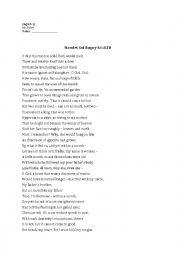

And so we come to his first soliloquy.Įach of Hamlet’s soliloquies has a different tone, and indeed different targets. To reason most absurd: whose common themeĬlaudius is prodding at an open wound, and a few lines later when he leaves with his new Queen he leaves behind a Hamlet who is seething, boiling over with a potent cocktail of frustration, outrage and anger. She is followed by Claudius, who at his most smarmy tries to argue him out of his black mood:Ī fault against the dead, a fault to nature, He becomes particularly bitter when it seems that she is suggesting that his continuing grief is common, that it is common for people to die, and he retorts: Ay madam, it is common, suggesting that she knows all about behaving in a common way. In the following lines we hear more of his barely suppressed bitterness, as he responds to his mother’s attempts to jolly him along. He is still in mourning clothes, standing out in the celebrating court scene marking Claudius’s ascension to power. The very first words that Hamlet speaks are ‘Aside’, to us rather than the people around him, his spitting embittered A little more than kin and less than kind. It is for this reason that this play highlights soliloquies so consistently. What actors need to do with these soliloquies is to give us the sense of a mind working they are thoughts as they occur to Hamlet, a deeply-thinking man. Even – or especially – when you know speeches well, there is no better way of refreshing your understanding of them by seeing and listening to great actors performing them. Check the bottom of this post for performances by actors Kenneth Branagh and David Tennant, as well as an RSC video explanation. It is used most significantly by Hamlet, and also, once and memorably, by Claudius. He uses it in other plays too (perhaps most powerfully in Macbeth – but nowhere else does it have such a prominent role. One of the most distinctive and important dramatic techniques that Shakespeare deploys in Hamlet is the soliloquy.

The second post based on a podcast I did a while ago: here ’s the first, on the opening scene.


 0 kommentar(er)
0 kommentar(er)
